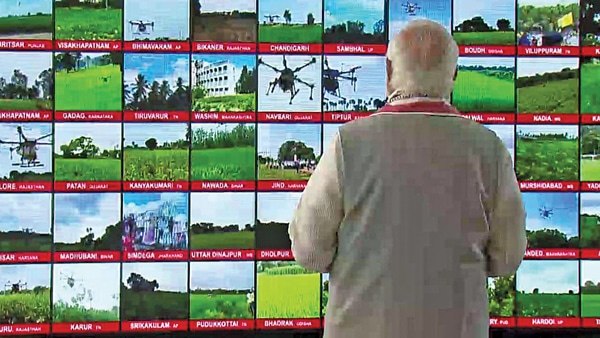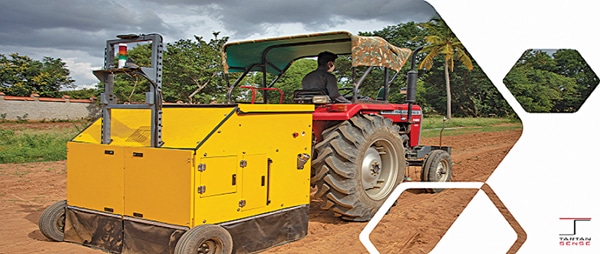Technology can aid farmers in overcoming problems ranging from climatic changes to demand fluctuations. However, the uptake by small farmers is still low, despite the range of affordable solutions available. How can Indian agri-tech startups reach the masses?
The world today is faced with a three-pronged problem—increase in population and food insecurity; decrease in supply of agricultural produce as an effect of global warming, consequent climatic changes, and natural disasters; and rise in greenhouse gas emissions by agricultural and food production sector further contributing to global warming. This vicious cycle can only be broken by what global entities have termed as ‘climate-smart agriculture.’

The World Bank defines Climate Smart Agriculture (CSA) as “an integrated approach to managing landscapes—cropland, livestock, forests, and fisheries—that addresses the interlinked challenges of food security and climate change.” CSA aims to enable the agricultural sector to produce more and better quality of food; be more resilient to problems like climatic changes, natural disasters, pests, and market eccentricities; and to reduce the carbon footprint per calorie or kilo of food produced, by reducing wastage, improving efficiency, avoiding deforestation, and finding ways to absorb carbon out of the atmosphere.
“Agricultural practices are being significantly transformed by emerging technologies. Timely prediction of crop readiness, crop-related diseases, and integrated demand-supply systems are essential for the Indian agricultural economy to grow. All this and more are achievable by what Intel’s CEO Pat Gelsinger calls the five superpowers—ubiquitous computing, pervasive connectivity, cloud-to-edge infrastructure, sensing, and artificial intelligence. The implementation of these technologies has the potential to enable Indian farmers to adopt more sustainable and cost-effective farming practices, while also facilitating climate-smart agriculture.
To accelerate the adoption of smart farming practices, we need to build Digital Readiness amongst farmers and the aligned ecosystem, enabling them to learn new tech skills, trust new technologies, and enhance the ability to use these superpowers responsibly and effectively for socio-economic benefits,” says Shweta Khurana, Senior Director – APJ, Government Partnerships & Initiatives, Global Government Affairs, Intel.
However, despite these benefits, the adoption at the grassroots level is still low. Rajesh Jalan, Chief Technology Officer, Cropin, says, “India is moving ahead with the adoption of smart farming technologies. Sensors and Internet of Things (IoT), automated irrigation, satellite imaging, and drone monitoring are already being used by sections of the agricultural sector—specifically corporate-supported farms, co-operatives, and large-holder farmers. However, compared to the size of India’s farm sector and the number of farms and farmers, the level of adoption is still low.”
Transitioning from Mere Automation to Smartness
Agriculture still sustains on traditional wisdom—and there are no second thoughts about that. However, it looks like farmers could do with a little technological help to deal with the changing (or challenging) environmental and market forces. Automation, with a good dose of intelligence, all strung together as a smart farming platform, could assist a farmer—and consequently the society—in several ways.

Machines: Robots, drones, and other machinery help automate several processes on a farm. They increase control over processes, reduce errors, improve productivity, and decrease wastage. Robots are used for weeding, planting seeds, harvesting agricultural produce, palletising, and more.
Take the case of fruit harvesting robots—they use sensors to detect each fruit’s development stage. Then, based on pre-programmed parameters, they pluck only those fruits that are at the right stage of ripeness. They are also made to handle delicate crops with care.
Similarly, smart sprinklers are often used to water crops. They usually work together with sensors that measure moisture levels of air and soil. They compare sensor readings against data about the moisture requirements of the crop, and provide just the right amount of water.
Drones are also handy helpers. They help in tasks like spraying fertilisers, monitoring fields and livestock, and mapping farms. Although it seems like automation will steal people’s jobs, in the agricultural sector that is not the case—there is no holiday on a farm, there is work to be done every day. But there is comparatively less labour available in villages today, with more and more people migrating to the cities in search of work.
Sensors: Sensors are a critical aspect of climate-smart farming, enabling several tasks ranging from automated irrigation to soil testing. Sensors are used to measure—and thereby control several aspects of a farm ranging from soil quality, light, and humidity, to movement and health of livestock, and much more. Sensors are indispensable in the deployment of smart greenhouses, where crops are grown under controlled environments.
Internet of Things (IoT): The IoT is the networking fabric that brings together the robots, drones, sprinklers, sensors, actuators, and other hardware on the farm. It integrates physical and digital resources, enabling remote monitoring and management of farm activities.
For example, data from sensors may be used to initiate sprinklers wherever moisture content is low, or alert the concerned personnel when this does not happen as programmed. The IoT feeds data from varied in-farm hardware to smart software platforms.
Artificial intelligence (AI): The use of AI marks the shift from mere automation to smart farming. AI turns the data collected by the IoT into actionable insights for farmers.
For example, AI tools can study the information from soil sensors, such as nutrient value, drainage capacity, acidity, etc, to gauge the health of the soil. It will further augment this with climatic conditions and weather predictions for that region, to suggest appropriate crops, which will give maximum yield in such a soil under such climatic conditions.
It will also take into consideration other factors like availability of seeds in that area, history of pest attacks on such crops in that region, water requirements of the crop versus water table in that region, and so on, before making the suggestions. If required, it may also suggest ways to boost soil health with appropriate nutrients.
Software platforms: Apart from individual software or apps that manage different aspects of the smart farm, we now see the emergence of a new generation of cloud-based, intelligent farm management platforms, which aim to integrate all of the farm’s needs. Such platforms are not out of reach of farmers as they are often available on a software-as-a-service (SaaS) model.
Solutions Galore – from Foil Testing to Pricing
Agri-tech is often classified as pre-harvest and post-harvest technologies. Pre-harvest involves testing the soil and selecting the right crops, planting, irrigating, spraying fertilisers, monitoring the farm, mitigating pest attacks, and other farming activities.
Post-harvest technologies involve quality checking, food processing, packaging, identifying markets, logistics, pricing, and so on. The goal of technology here is to maximise profit for the farmer, while also solving the problem of food insecurity by matching demand and supply.
Hardware, software, and cloud platforms play a major role in pre- and post-harvest activities. Let us look at some interesting solutions available for Indian farmers.
Agribots: From milking cows to harvesting, threshing, and packing, robots are used for a variety of tasks on farms. Apart from global players like Universal Robots, ABB, Nexus Robotics, Agrobot Harvester, Harvest Crew, and Farmwise, there are several interesting Indian startups also working in this space.
For example, Bengaluru based TartanSense makes robots for weeding, picking, and spraying operations on farms, while Gurugram based Intello Labs makes machines that can quality-check agricultural produce, sort, grade, weigh, and pack them too. Autonomous robots from Hyderabad based XMachines can be used for spraying, weeding, cutting grass, and transplanting saplings from trays.
Drones: According to a report by BlueWeave Consulting, the Indian agriculture drones market is forecast to witness a four-fold increase by 2028, with a projected compound annual growth rate (CAGR) of more than 25% during 2022-28. Small, medium, and large drones with fixed, rotary, or hybrid wings can be used for a variety of purposes like aerial mapping, soil, and field analysis, crop monitoring, health assessment, irrigation, and spraying of nutrients and pesticides.
For example, drones equipped with normalised difference vegetation index (NDVI) imaging equipment employ detailed colour information to determine plant health. According to the report, with a team of two operators, 10 drones can plant 400,000 seeds per day.
Through the Kisan Drone Suvidha, the Indian government is promoting the use of made-in-India drones, with 5-10kg capacities, for crop assessment, spraying natural pesticides and nutrients, and carrying small loads of farm produce to the market. The Department of Agriculture & Farmers Welfare has released the standard operating procedures (SOPs), which provide concise instructions for effective and safe operations of drones for pesticide and nutrient application.
Speaking at an event last year, the Agriculture Minister Narendra Singh Tomar said that the government is promoting the use of Kisan Drones by providing a financial assistance of up to 40% (maximum ₹400,000) for the purchase of individual drones. Plus, to make drone services available to farmers on a rental basis, financial assistance of 40% (maximum ₹400,000) is provided for purchase of drones.
Please register to view this article or log in below. Tip: Please subscribe to EFY Prime to read the Prime articles.






